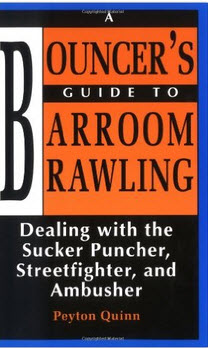
The Bouncer’s Guide to Barroom Brawling
August 12, 2012
“The best preparation for an event is the event itself.”
Bruce Lee
“Joe Lewis … one of the greatest Karate fighters of all time (said) that even in the prize ring he thought that the victor was decided 10 percent by technical skill and 90 percent by heart and fighting spirit. I can tell you flat out that this is also very true in the real deal in the street -and maybe even more so. In an actual assault proper mind set is far more important than technical skill.”
Peyton Quinn
 Peyton Quinn has written two seminal works on the subject of Strategic Streetfighting.
Peyton Quinn has written two seminal works on the subject of Strategic Streetfighting.
The Bouncer’s Guide to Barroom Brawling was published in 1990 and was Peyton Quinn’s first foray into tacking this subject.
It focused mainly on the most important aspect of fighting, which is avoidance. He also focused on another often overlooked area, aggressor-psychology. With these two skills in your pocket, you almost don’t need to know how to fight.
But I still want to know how to fight anyway.
That’s probably why he followed up with Real Fighting: Adrenaline Stress Conditioning Through Scenario-Based Training . This book was published in 1996, over fifteen years ago, but I feel that its ideas have yet to really penetrate the thinking behind martial arts trtaining for the street.
As I discussed in my article, Fear is the Mind Killer , adrenal stress is a physiological condition that happens when you go into fear mode. Your heart races and all sorts of bodily reactions interfere with your ability to respond according to your training (your hands shake, you get tunnel vsion, etc, etc).
The traditional martial arts solution to this problem is mega-repetition. Do the movement 1000 times or 10,000 times. Wing Chun’s solution is ChiSao, which can skirt along the edges of these adrenal effects if the fighters get emotionally-charged. Also, the idea is to train yorself to stay calm.
But this is easier said than done and it helps if you know what will really happen when you get jacked up by a confrontation.
Quinn’s solution was to train people in the adrenalized state. He adopted the “Bullet” suit, a padded suit built around a football helmet developed by Mark Morris for the Model Mugging/IMPACT program. He stuck his best guys this protective the suit and then encouraged a little street improv, i.e. to enact a fear-inducing scenario.
He had the suited trainer “woof” at the trainee, yelling at them, calling them names and generally intimdating them.
Reminds me of Basic Training.
He found most people could do a little method acting get an actual adrenal response. Then he had his trainee try to talk their way out of the fight. Randomly, he had the aggressor in the suit grab or hit the trainee. Then the trainee would respond full-force, hitting the aggressor in the suit with everything they had using one or two simple techniques they had been training at the camp (like a palm strike to the head).
I’ve never been able to afford to take Quinn’s Rocky Mountain Combat Applications Course (which requires going to Colorado, among other things) but have always been very interested in this concept. Quinn claims (if memory serves) that training in the adrenalized state actually sticks more successfully.
It makes sense to me to train in this adrenalized state. In such a state, your brain is actually being directed by your amygdala, the part of your brain that handles the fight-or-flight reflex. So training in this state works on that part of the brain directly.
Maybe my wife will send me to RMCAT for my birthday.